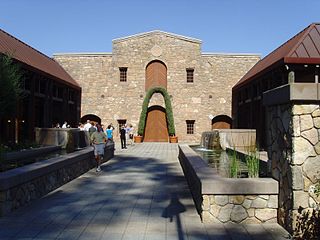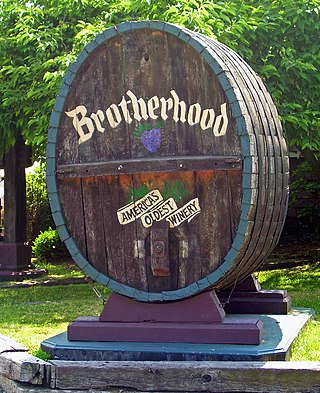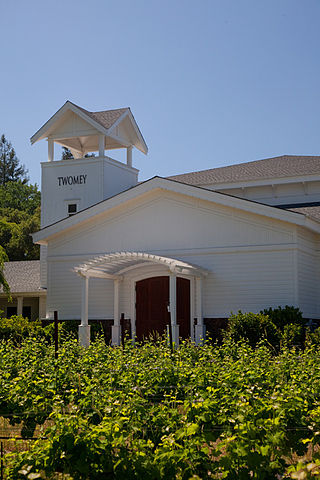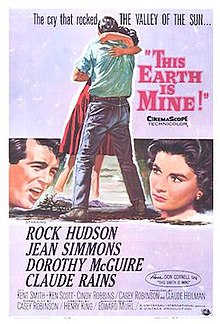
Napa County is a county north of San Pablo Bay located in the northern portion of the U.S. state of California. As of the 2020 census, the population was 138,019. The county seat is the City of Napa. Napa County was one of the original counties of California, created in 1850 at the time of statehood. Parts of the county's territory were given to Lake County in 1861.

A winery is a building or property that produces wine, or a business involved in the production of wine, such as a wine company. Some wine companies own many wineries. Besides wine making equipment, larger wineries may also feature warehouses, bottling lines, laboratories, and large expanses of tanks known as tank farms. Wineries may have existed as long as 8,000 years ago.
Miljenko "Mike" Grgić is a Croatian-American winemaker in California. He was born into a winemaking family in the town of Desne on Croatia's coastal region of Dalmatia. He is notable for being the winemaker behind the 1973 Chateau Montelena Chardonnay that bested several white Burgundy wines in the wine tasting event that became known as the Judgement of Paris. In recognition of his contributions to the wine industry, Grgich was inducted into the Culinary Institute of America's Vintner's Hall of Fame on March 7, 2008. The tribute came at the same time that Grgich was celebrating his 50th vintage of winemaking in the Napa Valley.

Heitz Wine Cellars is a California wine producer located within Napa Valley east of the town of St. Helena. An early modern era Napa Valley presence and pioneering exponent of French oak, the estate enjoys a historical renown with the success of its Martha's Vineyard Cabernet Sauvignon, and has also been described as a "master of Grignolino".
Napa Valley is an American Viticultural Area (AVA) located in Napa County in California's Wine Country. It was established by the Bureau of Alcohol, Tobacco and Firearms (ATF) on January 27, 1981. Napa Valley is considered one of the premier wine regions in the world. Records of commercial wine production in the region date back to the nineteenth century, but premium wine production dates back only to the 1960s.

Markham Vineyards is a US winery founded in Napa Valley, California, in 1874. Markham has operated continuously since its founding, making it the fourth oldest continuously operating winery in Napa County.
Heidi Peterson Barrett is a winemaker and entrepreneur who has been responsible for some of California's most notable cult wines. Her career has included stints at Screaming Eagle, Dalla Valle Vineyards, Paradigm Winery, Grace Family Vineyards, Amuse Bouche, Lamborn Family, Showket Vineyards, Revana Family Vineyards, Vineyard 29 and Fantesca. Barrett is a consultant for Diamond Creek Vineyards and Niebaum-Coppola, Kenzo Estate, and has her own wine label, La Sirena.

The history of American wine began when the first Europeans explored parts of North America, which they called Vinland because of the profusion of grape vines found there. However, settlers would later discover that the wine made from the various native grapes, had flavors which were unfamiliar and which they did not like. This led to repeated efforts to grow familiar Vitis vinifera varieties. The first vines of Vitis vinifera origin were planted in Senecu in 1629, which is near the present day town of San Antonio, New Mexico.
Windsor Vineyards is a winery located in Windsor, California, United States.
Helen Turley is a pioneering American winemaker and wine consultant. She is known for bringing several Californian cult wines to the public awareness, and as the owner of a 20-acre (8.1 ha) boutique winery, Marcassin Vineyard. She is the recipient of several prestigious American wine awards, to include Wine Spectator's Distinguished Service Award and Food & Wine's Achievement Winemaker of the Year.
Schramsberg Vineyards is a winery located in Calistoga, California in the Napa Valley region. The vineyard, which was founded in 1862 by the German immigrant Jacob Schram, produces a series of sparkling wines using the same method as champagne. Schramsberg is considered one of the premium brands in the production of sparkling wine in California and the first U.S. wine to "match the style and quality of the best French Champagnes".

Charles Krug (1825–1892) was among the pioneers of winemaking in the Napa Valley, California, and was the founder of the Charles Krug Winery.
Colgin Cellars is a winery in Napa Valley, California founded in 1992.

Blackbird Vineyards is a Napa Valley based winery. It is part of the Bespoke Collection. Founder Michael Polenske wanted to create a winery that focused on producing wines from Merlot grapes, which fits with the name "Blackbird", as merlot means "young blackbird", in French patois. Blackbird Vineyards creates wines inspired by the Pomerol area of France. The winery calls their wines "California Bordeaux".
Nicole Abiouness is an American female entrepreneur and winemaker. She owns and operates Abiouness Wines, in Mendocino County, Napa Valley, California where she makes Pinot Noir and Sangiovese wine.
Palmaz Vineyards is a Californian winery in the Napa Valley, primarily dedicated to Cabernet Sauvignon production. The estate is located on what was once the Cedar Knoll Vineyard Company, a pre prohibition winery, founded in 1881 by Henry Hagen, one of the pioneers of wine production in the Napa Valley. After prohibition the winery fell into a dilapidated state and the winery was abandoned. The Hagen House and the vineyards have since been restored after they were bought by Amalia and Julio Palmaz in 1997. The family operated winery and vineyards cultivate some 55 acres using sustainable farming practices, devote to Cabernet Sauvignon, Chardonnay, Riesling, Muscat along with smaller plantings of Merlot, Malbec, Cabernet Franc and Petite Verdot.

Twomey Cellars is a California winery. It was established in 1999 by the Duncan Family, who have operated the successful Silver Oak Cellars in California since 1972. The Duncan Family started Twomey Cellars to pursue varietals other than Cabernet Sauvignon. Twomey has three wineries: one in Calistoga in the Napa Valley; one in Healdsburg in the Russian River Valley; one in Philo in Anderson Valley, and produces mainly Pinot noir and Sauvignon blanc. Twomey’s Sauvignon blanc is a blend of Sauvignon blanc grapes from their estate vineyards at their wineries in Napa Valley, Anderson Valley, and Russian River Valley.

Artesa Vineyards & Winery is a winery located in Napa, California in the United States.
Elizabeth Vianna is a female winemaker and businesswoman who has been responsible for some of California's most notable Cabernet wines. She is one of America's few Latina winemakers, known for Bordeaux-style wines at Chimney Rock, a part of Terlato Wine Group.
Louis M. Martini Winery is a winery and distributor headquartered in Napa Valley, California.









